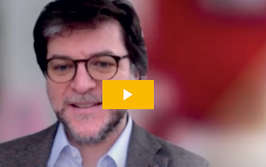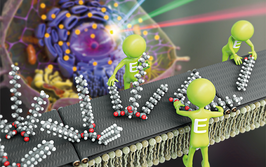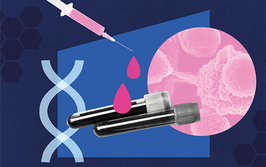The Cornerstone of Competency
Milestones provide a way to assess learners’ progress toward professional performance
Competencies aren’t like facts where you either know them or don’t; instead, you go through a series of milestones that cover the spectrum from novice to expert. There’s a continuum of observable behaviors by which a learner demonstrates that they have actually acquired the knowledge. That’s the real difference between this type of learning and previous kinds – now, it’s not enough just to say that you know something; you have to actually be able to show it.
My background is in graduate medical education. I spent the first decade of my career as program director of a hematology/oncology fellowship, including developing and implementing an assessment system for our fellows. We used the word “competency” – but only as a descriptive term for our objectives. If students were able to list the information we wanted them to know, then we considered them to have acquired proficiency. Clearly, that’s not the way we use the word nowadays!
It was the need for public accountability that prompted a revolution in American medical education. It was no longer sufficient to simply conclude that residents had capability based solely on their capacity to reel off medical knowledge; they needed to actually demonstrate it. As a result, there was a transition to a more milestone-based assessment method that takes learners from basic skills all the way to professional performance. Medical education is a continuum that runs from medical school to postgraduate training and residency fellowship and finally to practice. Our teaching and evaluation needs to follow the same continuum – so it seemed to me that, if we were implementing competency-based medical education (CBME) for our residents, it made sense to start at the beginning and introduce it in undergraduate medical education as well.
A generation apart
The current generation of medical students is perfectly suited for this new style of evaluation. The idea for our recent study – “Milestones and millennials: A perfect pairing – competency-based medical education and the learning preferences of Generation Y” (1) – came to me when I was developing milestones for our hematology fellowship. I presented them at a meeting where I also gave a talk on intergenerational learning – and it just became obvious how beautifully CBME and the current generation of learners intersected.
We use a milestone system that takes learners through different steps, and each subsequent step requires greater levels of observed competency. At the “novice” level, you may not be able to adequately discuss the goals of a particular intervention or the side effects of a treatment. At the next level, you might discuss it intermittently – inconsistently, or with errors or gaps in your knowledge. When you reach the “adequate” level, wherein you can apply your knowledge consistently and correctly, you’re considered ready for independent practice. But you’re not quite finished; there’s still the “aspirational” level, where you not only apply your knowledge properly, but can also teach other individuals to do the same. That’s how the continuum of milestone-based assessment works, and you can apply that to anything – interpreting a blood smear, looking at tissue under the microscope, distinguishing similar diseases... Milestones really are the cornerstone of CBME, because they allow us to effectively evaluate an aspiring doctor’s ability to do the job.


There’s no question that millennials are Internet natives, and their attitudes and approaches reflect that. They’re facile with technology, but they also tend to have fairly short attention spans; if you don’t grab their focus within a few minutes, you’ve lost them. And that can be easy to do if you aren’t teaching to their needs. I think that’s where technology can be very helpful – it allows learners to control what content they receive and how fast they receive it. That way, they can skip over sections they know well and spend more time on those they don’t. They can also network virtually to learn new material using tools like Google Docs and Twitter conversations. It’s very important for physicians to learn how to work in teams and, in that respect, millennials – to whom online collaboration comes naturally – are ahead of the game.
I mentioned earlier that one of the driving forces behind the transition to CBME is public accountability. That’s another area where millennials are one step ahead. As a group, they feel very passionately about making a difference in the world. Their desire to have an impact spurs them to become the best version of themselves that they can be – and, as a result, they respond extremely well to defined goals and directed feedback that helps them get there.
Mentoring millennials
Most millennials have been raised by “helicopter parents” who spend a lot of time running interference. They’re used to having an adult who is on their side, constantly looking out for them. Mentoring works very well with this generation of learners because they’re already accustomed to that kind of relationship – you don’t have to be their best friend, but you do have to demonstrate that you care about their outcomes to help them achieve their highest potential. I’ve found that it works best in an informal setting; if you build a relaxed rapport with them, they’ll be more open to receiving feedback and incorporating it into their work. It can be tricky to do that while still maintaining firm boundaries – assignment due dates, skills demonstrations, and so on – but if you tie those boundaries into motivations (“This will help you become a more professional and therefore a more successful pathologist”), it can be easier to encourage mentees without losing the friendly relationship. The mentor learns a new way of working with colleagues, whereas the mentee grows and develops professionally. I consider it a win-win!
But what about when the learner graduates from the relationship and becomes a leader in their own right? When mentoring is done well, one of the skills you teach your mentee is how to be a mentor themselves. The profession of medicine is one where the mentor-mentee relationship continues throughout your career. I have been in medicine for 25 years, and although I have mentored many students, residents and even junior faculty, I also continue to be mentored myself. It’s not an all-or-nothing, one-or-the-other situation; most medical professionals are both, and there’s a lot to be learned on both sides of the equation.
Faculty development is an extremely important – and sometimes overlooked – aspect of mentoring. We choose our faculty members and advisors carefully, but then we invest in them through annual development programs on mentorship. We even have a required half-day workshop on millennials: how they learn best, what tools educators can use, what resources are available, and how to handle hypothetical scenarios. We don’t just take it for granted that our faculty will know how to provide the best possible education for every student; instead, we equip them with the knowledge they need, and we cultivate their existing passion for teaching well.
Tips for teachers
Unfortunately, I think that millennials are often unfairly maligned. I think their attitudes – how they approach the educational process, how they receive feedback, how they work together – really set them up to thrive in a CBME context. I’d like to see educators around the world embrace this and realize that it’s actually quite easy to engage these learners if you genuinely invest in them. Give them specific milestones, help them understand how reaching those milestones will help them achieve their own objectives, and don’t make the mistake of setting your expectations low. These learners want to be challenged. They want to be held to high expectations. They want to work hard, do well, and accomplish extraordinary things. They genuinely want to make the world a better place – that’s why they choose careers in medicine; that’s why they pursue specialties like pathology – and it’s your job as an educator to help them do it.
- JR Desy et al., “Milestones and millennials: A perfect pairing – competency-based medical education and the learning preferences of Generation Y”, Mayo Clin Proc, 92, 243–250 (2017). PMID: 28160874.
Alexandra Wolanskyj is Associate Professor of Medicine at the Mayo Clinic, Rochester, USA.




















